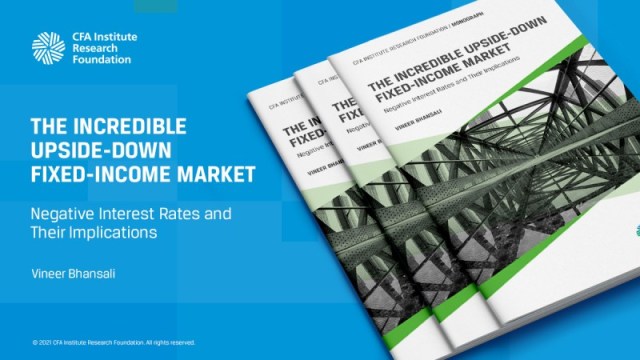[ad_1]
Is humanity at a stage of its development when interest on deposits will meet the same fate as the Walkman cassette player and be relegated to a quaint memory?
“It is entirely possible,” Vineer Bhansali, writes in the introduction to The Incredible Upside-Down Fixed-Income Market, a newly published monograph from the CFA Institute Research Foundation.
“That we are at the end of multiple centuries of financial market dominance is just conceivable, and negative yields are an intermediate mechanism to reset the system,” he says.
Bhansali, the CIO of LongTail Alpha, notes that the negative-yielding bond market is “like finding an amazing set of phenomena” that we first need to understand and then perhaps try to profit from. But, he concedes, accomplishing this is not so straightforward.
The monograph — a wide-ranging discussion of negative interest rates and bond yields — lays the necessary groundwork.
“Understanding a phenomenon that has no historical precedent is doubly difficult because few tools have been developed to analyze this type of environment,” Bhansali says.
What then to make of the current environment? What are the ramifications of negative yields? How will this affect economies and investors? Will the US Federal Reserve, which has so far resisted cutting rates into negative territory, change course?
For answers, I spoke with Bhansali by phone. I also asked him whether he thinks Jerome Powell, the chair of the US Federal Reserve, will keep his job when his term ends in February 2022, and what investors should make of the Treasury Inflation-Protected Securities (TIPS) market, among other questions. Below is a lightly edited transcript of the first part of our conversation.
CFA Institute: Thank you for making some time today and congratulations on the monograph. It was two years in the making, so that was a labor of love, I’m sure.
Vineer Bhansali: The target kept moving and things kept changing, but fortunately the topic didn’t change very much, so it ended up being pretty timely in the end.
You cover a lot of ground in under 100 pages, from who buys negative-yielding bonds and why, to the role of central banks, the consequences for asset valuation and risk management, to the rise of digital currencies. Let’s flip things around and start at the conclusion: Is there really anything wrong with negative yields?
That’s a really interesting question. So historically we have not seen negative yields. Ever. I’ve looked at a lot of history books, I have not found persistent nominal negative yields, at least in written history. Real yields, of course, do frequently go negative and real yields can go negative because inflation can be very high when nominal yields are low.
So, the question of whether there’s anything wrong, there are a number of different ways to answer, and first is just an analogy:
I’m a physicist by training. And there’s this concept that mass is always positive. That when you look at something, it weighs something that’s finite. It’s bigger than zero. Now, theoretically it’s possible that you can have negative mass. But in normal practice, no one has (yet) observed a particle with negative mass, though I presume it is possible to make something in the lab that behaves like a negative mass particle under very specific, fine-tuned conditions. Theoretically it’s possible that anything is possible.
Typically in physics you don’t find those kind of “violations” of fundamental physical laws.
In finance, of course, there’s nothing fundamental about negative yields. You can always take money away from depositors, which is basically what a negative-yielding bond is. And it’s very hard to say that it’s right or wrong philosophically. But it highlights this issue of whether interest rates actually signal anything in a world where monetary and fiscal policy have converged a lot.
So another way of saying this is that if governments are going to have to transfer money, and they’re not able to transfer in the traditional way by taxing, they might have to resort to other mechanisms. Europe is a great example of this, where the core European countries have to transfer money to Greece, Italy, and others for the union to hang together — and they can’t do that by taxation because there’s no unified fiscal mechanism through which you can have wealth transfers between regions like we have in the United States. But having negative yields is a different mechanism by which the ECB [European Central Bank] can essentially subsidize the borrowing by many of those countries.
So negative yields are, in a way, taking money from “savers” in the core European countries and transferring it to peripheral countries, to Greece, etc. So from a social perspective, one looks at it and says, “Well, that solves the problem of keeping Europe unified.” There’s nothing wrong with it since it achieves some political objective that might not be possible otherwise. It’s just a different form of wealth transfer that is not explicit taxation.
So I don’t assign too much in terms of philosophical value to it, but what I will say is that it definitely changes the calculus of finance.
So, if you just think about finance, where investment requires returns, then a negatively yielding bond violates a very basic, fundamental principle: the time value of money.
So while philosophically, there’s nothing wrong with it, it goes against everything that people have learned as far as financial theory goes.
You started this project two years ago. How did your thinking shift? Did you have an idea when you started of what the end point or the conclusion might be? And if so, did it shift between when you started and when you wrote the last chapter?
It was probably about five years ago when I first started thinking about why this is such an interesting problem, and I thought about it how a theoretical physicist would: I turned it upside down.
One of my freshman advisors when I was in physics was Richard Feynman and he used to always say — and this a long, long time ago — when you’re really looking at a brand-new problem, you’ve got to evaluate it from every angle: upside down, sideways, inside out — to try to really figure out what’s going on.
And when I first started, I was only looking at it from one perspective, from an investor’s perspective. Well, I thought, this was a distortion that probably would correct itself over time, it was an anomaly that would just go away, and so on. And then it became super pervasive, and then central banks started to justify it, and you’re seeing central bankers digging deeper and deeper into it for the various reasons we just spoke about: political reasons, fiscal reasons, and so on. So my thinking has definitely evolved in this.
And I’m less likely to look at it and say it’s right or wrong in an absolute sense. But I’m more likely to see why it might be required in the current state of the financial markets, and the dynamic is still evolving as a matter of fact. I mean, 20% to 25% of the existing fixed-income market is negatively yielding and the size of the fixed-income market is just massive, right? It’s trillions. So you’re talking about $20 to $25 trillion of negatively yielding bonds.
And it’s sticky. It’s not going away anytime soon, though in the last five years since I started thinking about the project and especially the last three years, I’ve tried to collect data and write about it and looked at models and history and so on as it evolved. And I think that’s the wonderful thing about doing “original finance,” especially what I do here: We’re looking at these very massive-scale aberrations, distortions, or differences without attaching a value to them.
And there is no historical precedent. There’s no theory that you can rely on and say, “Hey, by the way, that’s what my professor would have said you should be doing.” Everybody’s kind of figuring it out in real time.
Even the central banks are trying to figure it out. Their response and rhetoric just keeps changing. It’s a very path-dependent problem. And one thing I would say in conclusion to that question is that we are at a point now where it’s extremely hard to go back to what I almost feel is a very puritanical way of looking at finance. So many things have gotten demolished and broken in finance in the last three to five years. A lot of what I was taught or read when I was starting out in finance 30 years ago — such as the no arbitrage principle, which is based on there being no free money, yields cannot go negative, there cannot be a negative interest rate — those are all gone. That belief has just changed permanently.
So, I think that’s probably the biggest difference, that finance has now suddenly met politics and big government, and all the other things that come with it. And I think that’s going to be the natural state of affairs going forward.
You mentioned a moment ago that finance is broken, I think that was the word you used. So I have to ask then, how do we fix it?
So, I think you just have to adapt.
This is a beautiful question and it’s an interesting question, because 100-odd years ago, classical physics was broken when people realized there’s something happening in the atomic world that could not be explained using Newtonian physics and so on. I’m going to have to use physics analogies again because physics sort of went through these existential problems 100 years ago.
We had this pristine setup in finance where certain things were never supposed to happen, like interest rates going negative, always declining, or the discount factor increasing with time, and so on and so forth.
And that’s broken. And so now you’re in a world of quantum finance. It’s like, “Okay, well this too can break, how do you fix it?” Well you don’t fix it. You can’t ever go back to the old way of doing things. You have to realize now that with this amazing amount of debt that’s outstanding, the three or four major blocs — the United States, the dollar bloc, the European area, Japan, and then China — they all have very different objectives and agendas where finance is actually meeting politics.
So politics and finance, they’ve always been kind of tied together, but in the last 100 years, we lost this sense that they are converging at a very rapid pace. So you’re in the state now, I think the state for the next 15 to 20 years, where instead of fixing it, we just have to adapt ourselves to the reality that central banks now have the mandate to solve social problems. And if they’re going to solve social problems, some of these new things that we’re seeing, where stuff just “breaks” in the old sense of the word, is going to happen more frequently.
So, we
have to be an adaptive system, it sounds like.
Absolutely, yeah.
The opening quote of the monograph, from Sidney Homer’s A History of Interest Rates, says that the “Free market long-term rates of interest . . . provide a sort of fever chart of the economic and political health of that nation.”
Assuming you agree with the analogy that interest rates are a thermometer of the health of nations, what is the thermometer telling you now about the United States; Europe, specifically Germany; and Japan?
You’re using the quote that I picked up from Homer’s book on the history of interest rates. And that’s what he uses. I’m kind of paraphrasing here, but his theory is that interest rates have been good indicators of the health of nations and economies. I think when he wrote that particular passage, inflation was running very high, interest rates were double digits, and he said, “Look, it looks like everybody’s getting a fever here.”
And this was the 1980s when inflation and interest rates were very high, and everybody was hot, so to speak. Now you have another extreme where rates are negative or close to zero. So I do love the analogy. But the key word there and the key word here is “free.” If interest rates are free, they should reflect the health of the nation.
Right now, it would be a little bit tough to say that interest rates are free. Interest rates are where they are primarily because of extremely aggressive central bank policy.
And again, there are reasons why central banks have to be that aggressive. And they’re buying up almost all the bonds that are being issued, so it’s not free. But even if it was partially free, what we would be saying right now is that all these nations are essentially dead, or at least they’re ice cold. They have no pulse, they have no temperature. Because rates are zero, they’re buried underground. And that somehow doesn’t sound true because we know that the global economy, at least from the metrics that people use to measure it, is doing quite well.
So where interest rates are, which would indicate that these nations are basically dead and buried, is not where people’s perception of where the world economy and the markets are. This is, at the end of the day, the most interesting thing if I put my trader hat on. Because there’s this extreme dichotomy or mismatch between what the signals are telling you and what the markets say the signals ought to be telling you.
We’re
all zombies.
Yeah exactly. If interest rates were a good measure of the health of the economy, we’re zombies. That’s right.
Stay tuned in the coming weeks for the second installment of Lauren Foster’s interview with Vineer Bhansali. For more from Lauren Foster, check out the CFA Institute Take 15 Podcast series.
If you liked this post, don’t forget to subscribe to the Enterprising Investor.
All posts are the opinion of the author. As such, they should not be construed as investment advice, nor do the opinions expressed necessarily reflect the views of CFA Institute or the author’s employer.
Image credit: ©Getty Images / Tyler E Nixon
Professional Learning for CFA Institute Members
CFA Institute members are empowered to self-determine and self-report professional learning (PL) credits earned, including content on Enterprising Investor. Members can record credits easily using their online PL tracker.
[ad_2]
Image and article originally from blogs.cfainstitute.org. Read the original article here.





